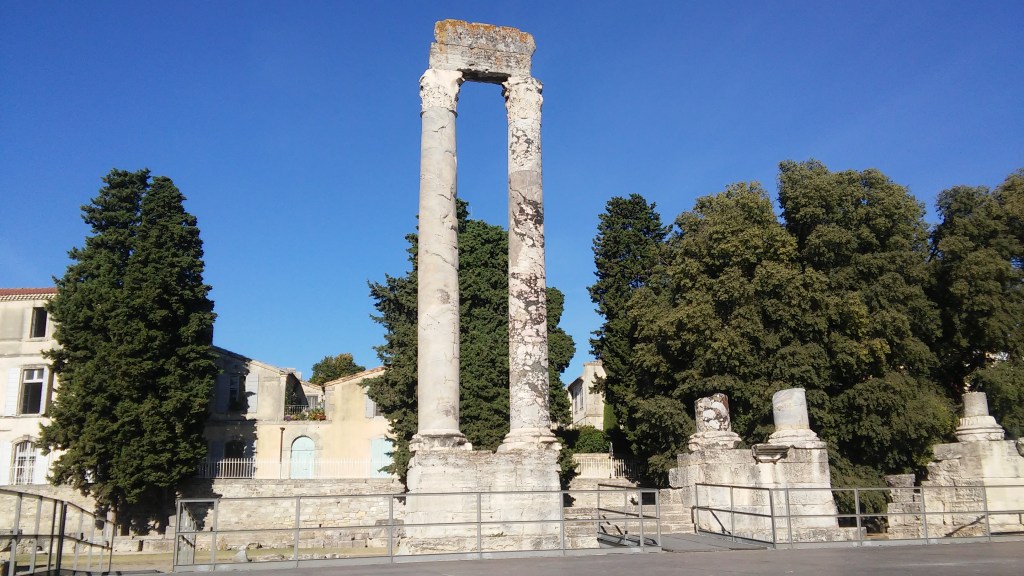I asked the waiter in Arles, is it possible to order a shrine (a dish of legumes and ducks)? The waiter explained slightly offended that this dish should be eaten in Carcassonne, and this is Provence, and here is a completely different cuisine.
In Arles, as if you were in Roman time. Here, as if there is no modern world. Ancient streets and buildings of the great Roman Empire everywhere. We lived a few meters from the huge Roman amphitheater in a tiny 3-storey castle with preserved ancient color – walls made of white soft stone, wooden ceilings with beams and creaky wooden stairs. Sleeping well there, despite the size of the rooms. My bed, in fact, was under the stairs. But, where else, will I sleep in a house that is several hundred years old?
In Arles, we stayed for 2 days. I had ideas to travel from Arles to the nearest towns of Provence. But, Arles was saturated with its interesting objects, and absorbed all our time and attention.
In the morning we arrived at the Roman theater (not to be confused with the amphitheater). We wanted to buy tickets, but we were told that admission is free for 6 objects and issued tickets. I did not understand what it was? Weekend promotion or common business. The theater preserved the atmosphere of ancient Rome, and in the silence and almost complete absence of visitors, comedies and tragedies of past centuries come to life on the local stage.
In this theater in 1651, Venus of Arlesian was found. The statue was created in the 1st century BC. The growth of Venus of Arlesian is 1 m 94 cm. They dug a well in the theater area and at a depth of 2 meters they found first the head, then the torso. A few years later, at the request of King Louis XIV, they searched for the hands of Venus. They rummaged everything, destroying a lot in the theater, but did not find hands. Now the statue of Venus of Arlesian is stored in the Louvre.
The next interesting ancient object of Alyscamps is the ancient necropolis. Van Gogh and other artists came here for inspiration and immersion in the world of eternal peace. A path leads past stone sarcophagi. The sarcophagi are empty.
We pass the family crypt and go into the old and half-empty temple. On the right in the niche, there is a well-preserved sarcophagus with images of sphinxes, Gorgon jellyfish. In its lower part are figures of a man and a woman. And above the sarcophagus is a Masonic symbol and throughout the room a stucco molding with Masonic symbols. This temple is the island of the dead, and the stairs leading down are the entrances of the kingdom of Hades.
After this place, we noticeably leveled off, calmed down and went to study the next object located on Republic Square. In Arles, everything is close, due to its small area and the large number of historical places. In the Republic Square, the cathedral of St. Trofim attracts attention. Unusually beautiful columns and figures adorn the entrance, and not at all of biblical themes – griffins, strange mythical creatures. Previously, there was a Christian basilica of the V century. During the French Revolution, this cathedral housed the temple of the Supreme Being. In 1178, Emperor Frederick I Barbarossa was crowned in the cathedral; in 1365, Emperor Charles IV was crowned here. Inside the cathedral there are many niches with the relics of saints.
Near the cathedral in the city hall building is the entrance to the crypto portico. We descend about 2 floors down into long stone galleries. In some places there are glasses on the floor, under which it is clear that there is another underground floor.
This place looks like an underground city. After going through all the underground corridors and thinking about the purpose of these corridors, we go up and go along one of the streets that extend from the Republic Square.
Suddenly, we get to the square with the famous yellow cafe Van Gogh. We could not get past such a place. We drank coffee in a famous place. I would not say that there is something special here. As always, the ubiquitous people of Chinese appearance were sitting at the adjacent tables, homonizing and creating a crowd.
The next point of our program in Arles was the Van Gogh Museum. They also said that the visit is free and issued entrance tickets. The museum has 3 floors. There are very worthy pictures. And from above there is an observation deck with a view of the red brick roofs of the city.
Finally, we went to the amphitheater next to our house. It was repaired by building a bowl with seats with metal structures and now concerts and events are being held in it.
The amphitheater was built during the reign of Emperor Constantine and is very large, but still smaller than its counterpart in Rome.
In Arles, a few more interesting places remained unseen by us, but an overflow of impressions had already begun. One more day had to be planned for Arles. A special city that has remained in its great past and lives in its own slow, special rhythm of life.
September 14-15, 18g.













I love Provence. I’m a little confused–you said they couldn’t find Venus’ hands, but in the picture she has hands. Did someone sculpt new ones for the statue?
LikeLiked by 1 person
Thanks. I am also delighted with Provence.
Yes, Venus’s hands made new ones. Until now, scientists have been arguing about what she had in her hands, how her hands were located.
LikeLiked by 1 person
That’s interesting. Thank you for sharing 🙂
LikeLike